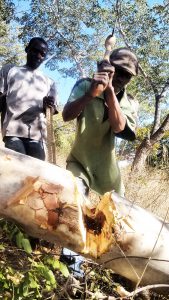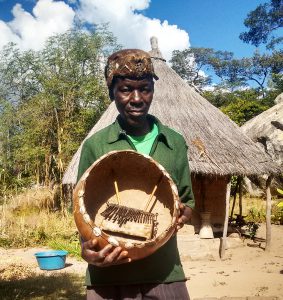
Matepe, madhebhe and hera are similar types of mbira that are traditionally played in northeastern Zimbabwe and central Mozambique. These instruments are played with four fingers, two thumbs plucking down and two index fingers plucking up. The 3 are very similar in construction, layout and tuning, but have some differences in repertoire, playing style, sound aesthetic, and build. Matepe typically have 26 keys, madhebhe 24, and hera 29.


Recordings Available from MBIRA
Video
Construction of the Instruments – Similarities

All three types of instrument soundboards are traditionally made with medium-soft wood, usually from the mupepe or mutondo trees, and are hollowed out in a bell shape. The keys are made by heating up and then flattening spring steel wire with a hammer, sando, or traditionally from smelting iron-ore in a blacksmiths’ forge. The length, width and thickness of each key determines the overall pitch, including overtones, which play a prominent role in the sound and aesthetic of the music. The tuning is adjustable based on the length of the keys and where they rest on top of a metal bridge.
The keys are held on the bridge by a metal bar that is wired tightly to the soundboard. At the top end of the instrument the keys rest on a strip of hardwood currently called piro, (from English, pillow) that prevent the keys from digging in to the softer wood during tuning.

In the hollow of the soundboard there is usually a metal rod that spans the opening. Metal rings, masarima, loop around this rod to add a buzzing sound, as well as amplification.
These instruments are usually further amplified by placing them inside resonators made from either fiberglass or large gourds called matende or mateze (dende, deze singular). The instrument is wedged inside and connected vibrationally to the deze with one or two wooden sticks. Commonly, two small nails are tacked into the underside of the soundboard, one on each corner. The nails allow the instrument to rest on the lip of the deze, exposing the hollow for the best sound. Another method of propping the mbira is to wire in an additional small rounded piece of gourd to the inside of the resonator. This creates a smoother space for instrument contact and lifts the instrument, allowing more room for the player’s hands. Metal bottle caps and/or land-snail shells adorn the resonators and provide additional buzz.
Matepe, hera and madhebhe players can and do play together, as the instruments and pieces are similar enough to do this easily.
Regional differences

Instrument names
The difference in the 3 instruments’ names can be divided by region and ethnic groupings. In Zimbabwe, hera is played north of the Mazowe river in Rushinga district by the Korekore/Tavara people, madhebhe is played south of the Mazowe river in Mutoko and Uzumba Maramba Pfungwe (UMP) districts by the Buja, and to the east in Mudzi district it is called matepe by the Toko-Tonga and Marembe peoples.
In Mozambique, the matepe is said to be played by the Marembe people up to Changara. Near the Zambezi river in Tete, the hera is said to be played by the Nyungwe people. In the section of Mozambique just north of Rushinga district in Zimbabwe, the hera is played by the Tavara people.
The names matepe and madhebhe refer to low sounds of the mhondoro (ancient spirits which may inhabit lions): Matepe/madhebhe dzemhondoro, the deep notes of the ancient spirits. The name hera could stem from the root word kuera – to be sacred, or may refer to the Hera people. Or, musician Chaka Chawasarira states that “heera” comes from the root word kutevera – to follow – meaning that the instrument is based on the 12-key karimba from Mozambique.

Construction
Variation in the size and design of matepe, madhebhe and hera is driven by the creativity or mood of the builder, and/or desires of the instrument buyer. Any of the 3 could be very small or very large .
Differences in construction based on region/ethnic group are primarily in the shape of keys, key layouts/numbers of keys, and the tone/overtones of the instrument.
Matepe keys generally curve dramatically upwards toward the players. Hera keys tend to have an “S” shape, curving up and then down again. Madhebhe keys typically have a less dramatic upward curve and sometimes come to a distinct bulbed or ‘bull nose’ end.

Matepe typically have 26 keys, madhebhe usually have 24, and hera 29. Compared to the other two types, matepe typically have 2 more high notes in the right hand lower row, which are the two highest notes on the instrument. These double the pitch of the high overtones in the left hand upper octave bass notes. The main difference of the madhebhe key layout is the organization of the left hand bass notes, where all of the top row of notes are shifted one space to the right. Interestingly, this maintains the organizational layout of notes found on another type of mbira, the nyonganyonga or malimba, played by the Barwe and Sena people in central Mozambique. On the hera, the same two notes added to the matepe lower row are placed in their own upper right row along with the next two pitches down (duplicating notes of the right index finger high end) plus usually one or two additional higher notes, for a total of 4 to 6 keys in this special row of keys. Additionally, builders can innovate and add notes that they want to hear in their playing.
Matepe and madhebhe typically have a deeper, lower, sound than hera. Their design (most likely the key shapes) allows loud low fundamental bass pitches, especially when placed in resonators. The high overtones are not as dominant as these low pitches. Hera have a ‘shiny,’ ‘shimmery,’ ‘glossy,’ sound, and their high overtones are heard more than the bass fundamentals.
Overtones are a Defining Characteristic

Overtones are a defining characteristic of matepe, madhebe, and hera that gives their music a full sound. The left hand bass keys carry two loud pitches; the low booming bass and high overtones which match the pitches of keys played by the right thumb and index finger. This creates great complexity on one instrument.
Ensemble Playing
Matepe, hera and madhebhe can be played either solo, or with 2 or several players. Singing by both mbira players and others present is typical, as with other types of Zimbabwean mbira.
In solo playing, the two thumbs and two index fingers create complex melodic and rhythmic patterns. When additional players are present, bass notes will not be played at the same time as the player(s) sitting next to a musician, but instead slightly earlier or later. The same is true for notes played by the right hand. The notes played by the left index finger, which can be steady and driving, usually have a different rhythmic feel than adjacent players.
This density of mbira sound is intense and is complemented by the singing: long soaring vocal lines by women and men, with improvisation.
Overlapping Repertoire
Overlapping repertoire allows musicians from different areas to play matepe, hera and/or madhebhe together. Most of the pieces are recognizable by players from various areas, although they call them by different names, have different singing lines, and even sing them in different languages. Here are some core pieces in the matepe, madhebhe and hera repertoire, played on more than one instrument. Of course, there are other pieces that are only playin on one instrument/in one area.
- Marume Ashora Mambo (matepe), Marume Azere Dare (hera), Endai Kwenyu kumaPotukezi (madhebhe).
- Msengu (matepe and madhebhe), Koodya Hove Kuna Mazowe (matepe), Pasi Panodya (hera).
- Mauya mauya (madhebhe), Nzou Ichidya Mushonga (matepe), Ndonda (hera).
- Aroyiwa Mwana (matepe), Darai Romba (hera).
- Siti (matepe), Kanotamba mubani (hera).
- Wako Ndewako Ureva Naye (matepe), Mwana Wamambo Haanodaro (hera).
More Information
For more information on matepe, madhebhe and hera: Jocelyn Moon’s Research Blog
Page Author
This page was written by Zack Moon, based on his 2016-2017 visit to Zimbabwe with Jocelyn Moon, where they spent time with musicians who play these 3 instruments, and recollections and writings of Andrew and Heather Tracey. Edited by Erica Azim.